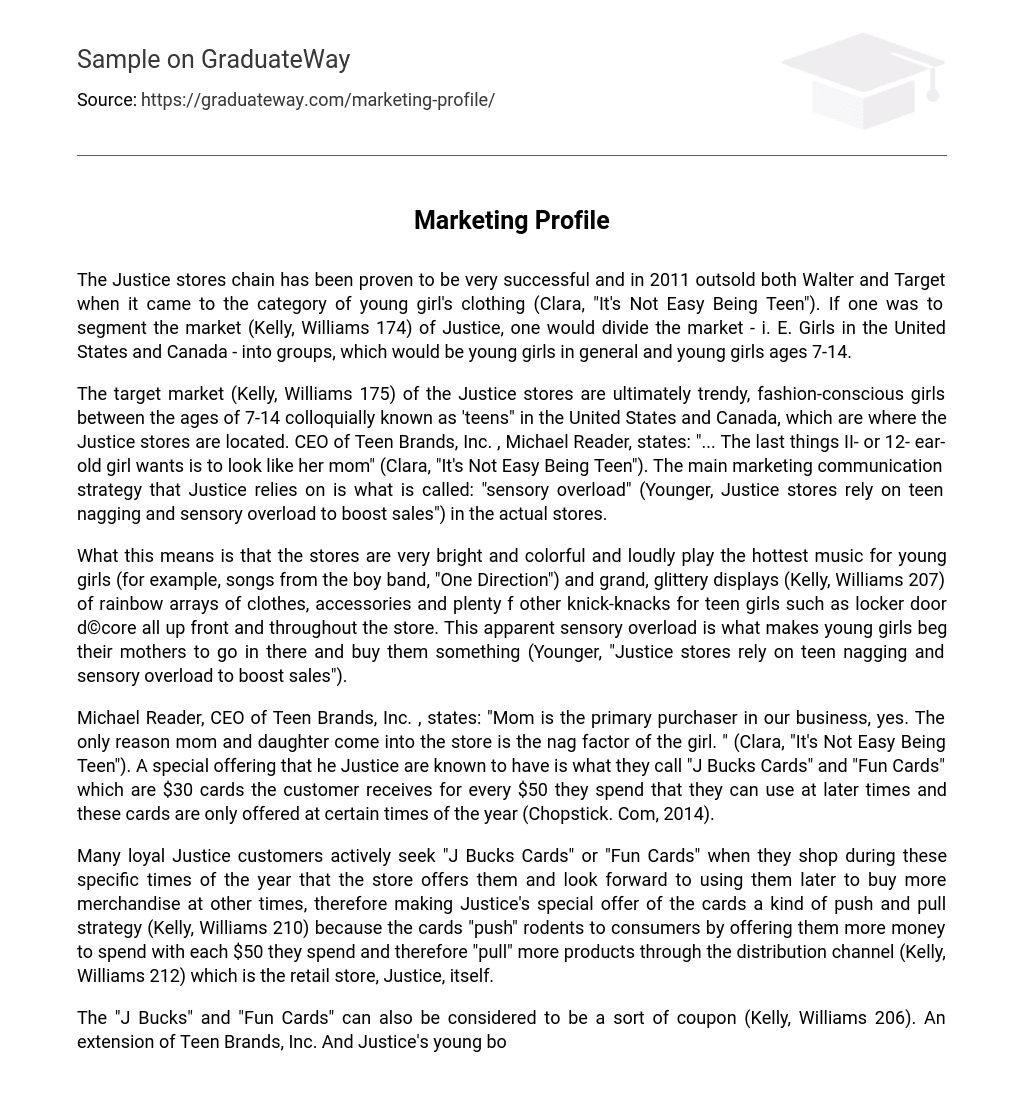The Justice stores chain has been proven to be very successful and in 2011 outsold both Walter and Target when it came to the category of young girl’s clothing (Clara, “It’s Not Easy Being Teen”). If one was to segment the market (Kelly, Williams 174) of Justice, one would divide the market – i. E. Girls in the United States and Canada – into groups, which would be young girls in general and young girls ages 7-14.
The target market (Kelly, Williams 175) of the Justice stores are ultimately trendy, fashion-conscious girls between the ages of 7-14 colloquially known as ‘teens” in the United States and Canada, which are where the Justice stores are located. CEO of Teen Brands, Inc. , Michael Reader, states: “… The last things II- or 12- ear-old girl wants is to look like her mom” (Clara, “It’s Not Easy Being Teen”). The main marketing communication strategy that Justice relies on is what is called: “sensory overload” (Younger, Justice stores rely on teen nagging and sensory overload to boost sales”) in the actual stores.
What this means is that the stores are very bright and colorful and loudly play the hottest music for young girls (for example, songs from the boy band, “One Direction”) and grand, glittery displays (Kelly, Williams 207) of rainbow arrays of clothes, accessories and plenty f other knick-knacks for teen girls such as locker door d©core all up front and throughout the store. This apparent sensory overload is what makes young girls beg their mothers to go in there and buy them something (Younger, “Justice stores rely on teen nagging and sensory overload to boost sales”).
Michael Reader, CEO of Teen Brands, Inc. , states: “Mom is the primary purchaser in our business, yes. The only reason mom and daughter come into the store is the nag factor of the girl. ” (Clara, “It’s Not Easy Being Teen”). A special offering that he Justice are known to have is what they call “J Bucks Cards” and “Fun Cards” which are $30 cards the customer receives for every $50 they spend that they can use at later times and these cards are only offered at certain times of the year (Chopstick. Com, 2014).
Many loyal Justice customers actively seek “J Bucks Cards” or “Fun Cards” when they shop during these specific times of the year that the store offers them and look forward to using them later to buy more merchandise at other times, therefore making Justice’s special offer of the cards a kind of push and pull strategy (Kelly, Williams 210) because the cards “push” rodents to consumers by offering them more money to spend with each $50 they spend and therefore “pull” more products through the distribution channel (Kelly, Williams 212) which is the retail store, Justice, itself.
The “J Bucks” and “Fun Cards” can also be considered to be a sort of coupon (Kelly, Williams 206). An extension of Teen Brands, Inc. And Justice’s young boys counterpart is a retail store called “Brothers” that is instead aimed at young “teen” boys ages 7-14 and operates and works in the same fashion as Justice does (Kara, “It’s Not Easy Being Teen”). Additionally, Justice, as of 2006, also hosts birthday parties that have themes such as “rock idol” or “movie star” and these birthday parties average up to 157 parties, which is about 1, 100 girls, every couple of months (Lappets, ‘Teen Brands revisits first strategy’).
The birthday parties serve as sort of a promotional premium (Kelly, Williams 192) because although you have to pay to have the party there, all the party supplies related to the theme are freely provided by the store and also there is the temptation of being in the store itself which makes customers want to buy products from the store. Also, Justice mails out to over 1 million households what is called a “Catalina” or a catalog/magazine hybrid. Like the store itself, the “Catalina” is bright and colorful and appeals to young girls and is a form of advertising through direct mail (Kelly, Williams 205).





